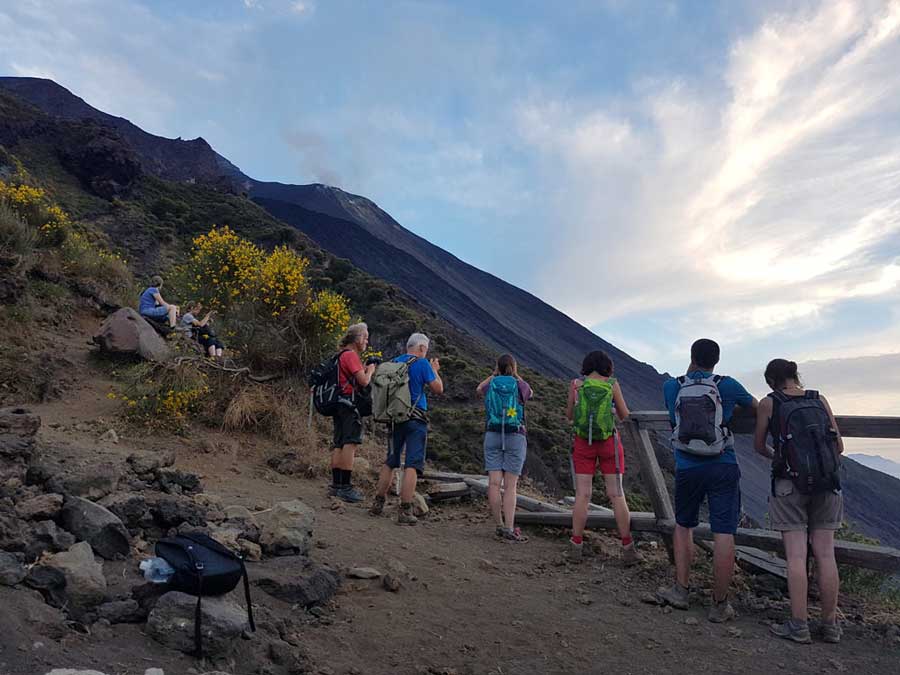Stromboli is the most dramatic of the Aeolian Islands (Isole Eolie or Isole Lipari in Italian), and is a popular daytrip destination from the other islands and from the Italian mainland. The island is an ancient and active volcano rising massively from the Mediterranean, with a couple of small settlements on the coast. It is an incredible and awe-inspiring sight, with a unique island atmosphere that attracts not just tourists but also film-makers and style-setters (former Italian president Giorgio Napolitano and designers Dolce and Gabbana – who owned a villa – are among celebrities who holiday here). Sitting on a tourist boat off the shore of Stromboli at dusk, while merry passengers applaud and toast the volcano’s lava spurts with sweet local wine, is one of the most surreal things I’ve experienced in my travels around Italy.
There are basically three things to do on Stromboli. One is to potter around the main village, admiring the views – though from here the volcano’s crater is not visible – and looking at volcano souvenirs in little shops. The second is to take a boat trip around to the Sciara del Fuoco, the steep black lava scar down the volcano’s side, where you can see Stromboli’s explosions. This is most dramatic after dark, when fiery emissions are clearly visible. The third activity, not for the faint-spirited or the unfit, is to climb the volcano and see eruptions at much closer quarters.
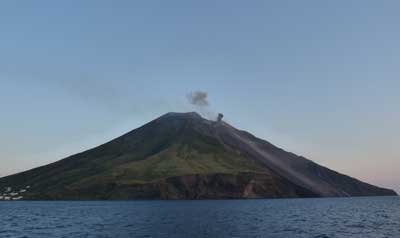
About the volcano
Stromboli has been erupting for as long as records exist. The Romans called it the ‘Lighthouse of the Mediterranean.’ Locals refer to the volcano as ‘iddu,’ a dialect word meaning ‘him.’
The volcano gives its name to a type of eruption: strombolian. It has been erupting pretty continuously for two thousand years, and tourists flock here to watch from a safe distance as lava and gas are ejected from craters just below the summit at intervals of roughly twenty minutes. In the daytime this is visible as a plume of gas looking like smoke. At night, you can see fiery red fountains shooting upwards.
Stromboli has been inhabited for thousands of years; some Greek-era archaeological finds from the island are now in the museum on Lipari. Life on the island was based on farming the fertile ground near the shores, and on fishing. By the middle of the twentieth century, prompted by a big eruption in 1930 which damaged buildings, and by the prospects of emigration, many of the islanders had departed and the population had dwindled. But after Roberto Rossellini’s 1950 film Stromboli terra di Dio drew attention to the island-volcano’s unique attractions, tourism began to give new life to Stromboli. Although there are still neatly-cultivated allotments and fishing boats drawn up on the beach, many of the 500 locals now make a living from renting out accommodation to tourists, from running tourist businesses and shops, or from working as mountain guides and leading volcano excursions. Although the island does attract lots of tourists each day during the summer months, new buildings are limited and the island’s sense of gritty, isolated other-worldliness and its fiery crater are great draws for the cognoscenti as well as trippers.
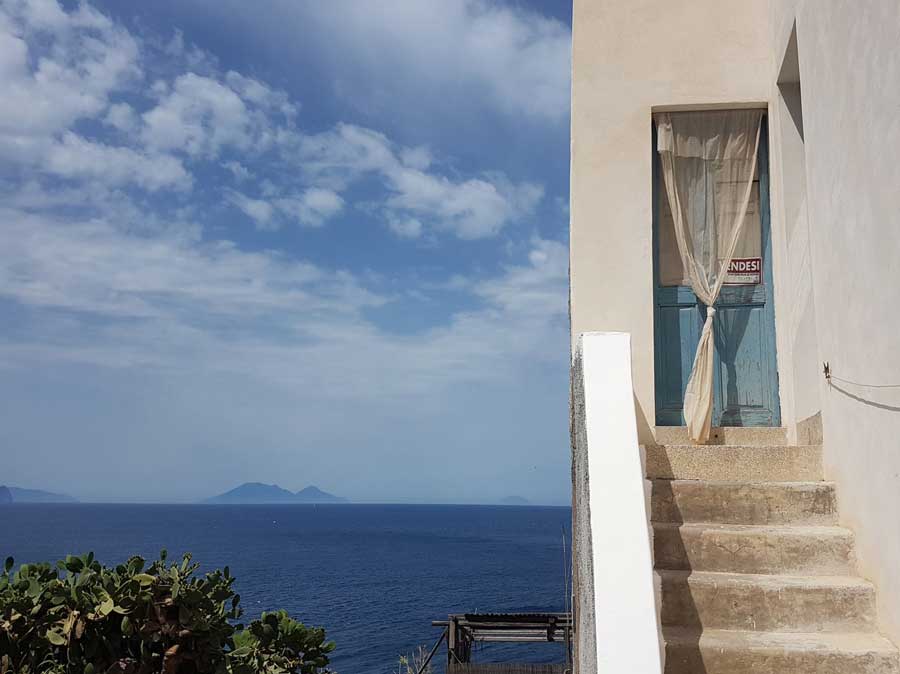
Walking up Stromboli
Climbing the volcano is only permitted with an offical guide, and there is a limit to the number of people allowed to visit the crater each day. Around the Scari landing jetty and village you’ll find advertisements and businesses where you can book a guide and also hire hiking boots and other equipment. Guides will generally provide the protective helmets which you’re required to wear. In the height of summer, try to reserve in advance to be sure of a place on an excursion. Walks generally set off in the late afternoon, to arrive at the crater for dramatic pyrotechnics at dusk. The outing takes around five hours, and should only be attempted if you are confident of your fitness. See the links panel on the right to research a volcano excursion or book a guide online.
When the volcanic activity levels are rated as high, the area around the craters is placed out of bounds, so a trip can never be guaranteed. Enquire in advance before your visit, and keep an eye on local reports. You may still be able to enjoy a walk at a lower altitude and see the explosions from a safer distance.
Stromboli villages, sights and beaches
Stromboli
There is one principal settlement on Stromboli, clustered on slopes near the seashore. This large village is generally termed ‘Stromboli’, though different districts have their own local names, beginning with Scari, the principal arrival point for Stromboli. There is a jetty for ferries and some places to buy refreshments. Stalls advertising boat tours and volcano excursions dot the waterfront and the lane climbing up to the heart of Stromboli village. Alongside is a picturesque stretch of shingle beach, where fishing boats are pulled up on the volcanic sand and pebbles. Uphill, along narrow lanes past souvenir shops, and flowers clambering over whitewashed buildings, visitors arrive at the little piazza in the part of Stromboli called San Vincenzo. The island’s principal church, the Chiesa di San Vincenzo, makes a pretty picture against the slopes of the volcano. Here you’ll find a cafe, a panoramic terrace and also places to book walks up the volcano.
Beyond the headland north of Scari are Ficogrande and Piscita, two more districts of Stromboli. Ficogrande has a beach of black volcanic sand. There are views towards Strombolicchio, a curiously-shaped volcanic outcrop in the sea that is like a little sister to Stromboli.
At night the streets of Stromboli are not illuminated by streetlights, so if you are staying here you should bring or borrow a torch.
Ginostra
Ginostra is a tiny village on the opposite side of Stromboli to the main settlement, on the south-western shore. The two villages were connected by a path which encircled the volcano, but landslide damage and neglect led to its abandonment, so unless the path is rebuilt, Ginostra can only be reached by boat. Ginostra is a simple little place, with a couple of restaurants and shops, and donkeys for transport. The hamlet was only connected for electricity in 2004. It can be visited on tourist boats which tour the coastline, or by using the regular ferry and hydrofoil services. The atmosphere here is peaceful and a contrast to the busier spots on the other side of Stromboli. There aren’t beaches at Ginostra, but it is posible to bathe from rocky shores.
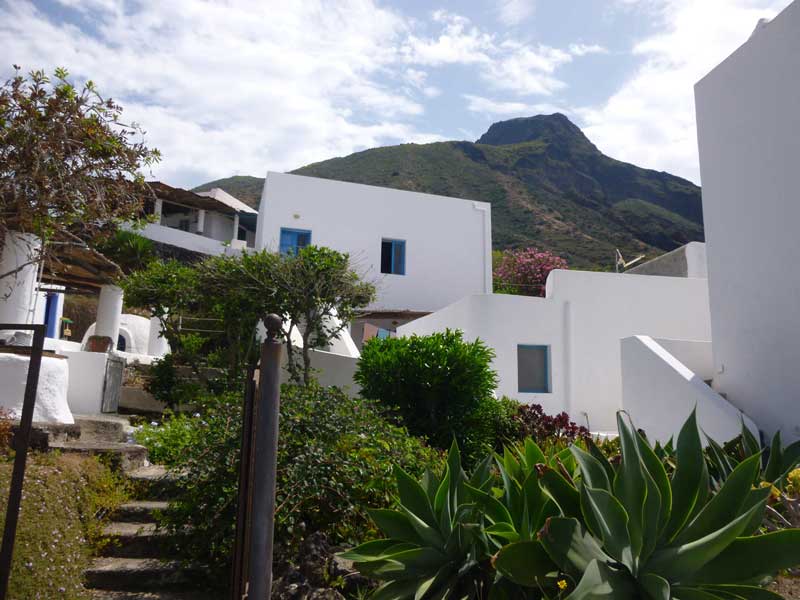
Volcano warning
As Stromboli is an active volcano, safety and certainty are not guaranteed. Walks to the crater can be called off when weather or volcanic conditions are deemed dangerous. Lava flows, when they have happened on Stromboli, have taken place down the Sciara del Fuoco slope, away from houses. Explosive events big enough to damage buildings are very rare. There have been occasional warnings of localised tidal waves when lava slides into the sea. Obviously, when visiting the island, travellers should follow local advice and heed any warnings and instructions that are issued by authorities or qualified volcano guides.
Books and films
One of the few non-volcanic tourist sights of Stromboli is a small house (pictured) painted deep red. This is the building where the film director Roberto Rossellini lodged with his leading lady Ingrid Bergman while filming Stromboli terra di Dio – a scandal at the time, as they were both married to other people. A plaque records the famous guests, and the making of the film.
If you read Italian, look out for the works of local author Fabio Famularo, who has written evocative books about life on Stromboli, including Il richiamo silenzioso del vulcano, an atmospheric historical novel.
Travel to Stromboli
You can find information on reaching Stromboli on my Aeolian Islands homepage. Some ferry and hydrofoil services from Sicily and the mainland stop at Stromboli; alternatively travellers can change on Lipari for a connecting ferry. Stromboli is north-east of the other Aeolian Islands, and the hydrofoils from Lipari can take as much as an hour and forty minutes. Services from Messina in Sicily take just under an hour and a half; there are also twice-daily summer hydrofoils from Reggio Calabria in mainland Italy, which take several hours. In the summer Alilauro run services from Naples. Palermo is another embarkation point, but the most frequent and reliable ferries for Stromboli, as for the other Aeolian Islands, is Milazzo in Sicily. For the latest ferry times, check with the websites of the different ferry companies which serve the Aeolian Islands (see links panel). There are more routes, and more services in the summer months, between June and September.
Travellers visiting the Aeolian Islands should be aware that ferry connections can be delayed or cancelled due to sea conditions. It’s good to have a spot of leeway in your travel plans.
In the summer Stromboli can be visited as part of a day excursion from various resorts on the neighbouring shore of southern Italy, like Tropea. If you want to spend longer on the island, you may be able to negotiate one-way travel with one of the tourist firms organising these excursions.
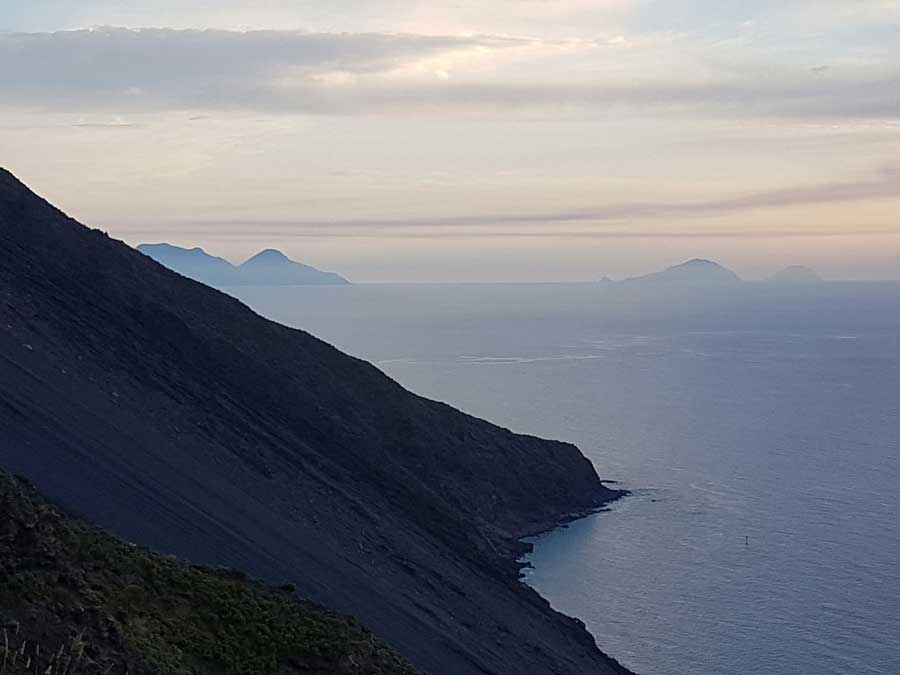
Excursions and boat trips
As well as the possibilities offered by scheduled ferry services, there are also firms and boatman offering excursions around Stromboli, out to see the volcano’s eruptions, and to visit the other islands.
Accommodation on Stromboli
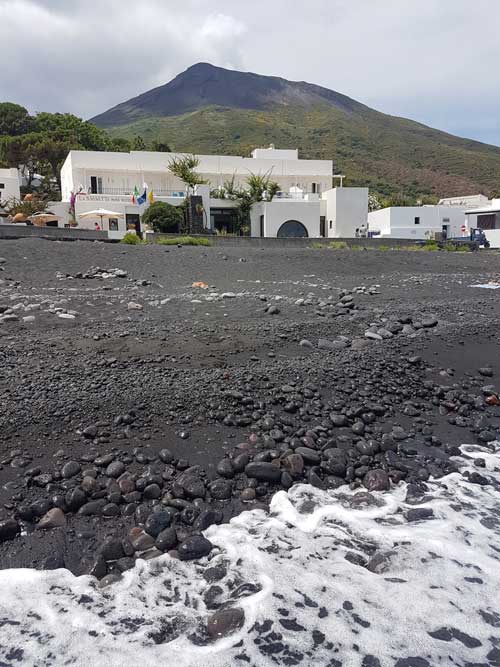
There aren’t a great many places to stay on Stromboli, and some are booked up well in advance by groups planning a volcano hike. I’d strongly recommend planning ahead, especially if you are travelling in the busy summer months, or simply want to be assured of your place to stay. You’ll find smart hotels, basic hotels and apartments and rooms to rent. I’d guess the majority of visitors stay only for one night, but if the island’s strange atmosphere might appeal to you, it’s worth considering a longer stay.
I’ve stayed twice at the Sirenetta Park Hotel, a friendly place to stay with flowers growing among its terraces and a large swimming pool, which you may have to yourself in late afternoons when other tourists are on their way to watch eruptions. The hotel provides lifts to and from the ferry. It’s right on the beach, so I’ve literally wandered out from breakfast, crossed the lane and walked over the black volcanic beach and into the sea.
On this site
South to Calabria: a travel itinerary finishing in the Aeolian Islands
Hotels in Italy – what to expect
Useful external links
Air Panarea (helicopter connections)
Volcano of Stromboli – information from the local authority
Stromboli Online – volcano information
Volcano guides
Stromboli Adventures (in Italian)
Ferries
